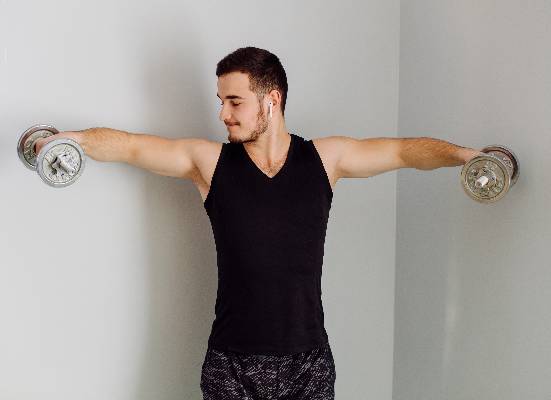Best Deltoid Muscle Exercises for Strength and Growth
Introduction to the Deltoid Muscle
When it comes to building a strong, well-defined physique, the deltoid muscles often steal the spotlight. These powerful muscles play a crucial role not only in aesthetics but also in functional strength and athletic performance. Whether you’re lifting weights at the gym or simply trying to master that overhead press, your deltoids are key players.
But why should you pay special attention to this muscle group? Strong deltoids enhance shoulder stability, improve posture, and allow for a greater range of motion. Plus, they can make your upper body look impressively sculpted. If you’re ready to take your workouts up a notch and develop those shoulders like never before, you’re in the right place.
Let’s explore some of the best deltoid muscle exercises for strength and growth that will help you achieve impressive results without overwhelming yourself with complex routines or equipment!
Benefits of Strong Deltoids
Strong deltoids are essential for a well-rounded physique. They give your shoulders a defined look that enhances overall body aesthetics.
Having strong deltoids improves shoulder stability and mobility. This can help prevent injuries during various activities, from lifting weights to everyday tasks.
Deltoid strength also plays a key role in athletic performance. Whether you’re throwing a ball or swimming, powerful shoulders contribute significantly to your power output.
Additionally, developed deltoids support better posture by counterbalancing the muscles of the chest. This alignment helps reduce strain on your back over time.
Incorporating exercises for the deltoids into your routine not only boosts strength but also aids in functional fitness, making daily movements smoother and more efficient.
Types of Deltoid Exercises (Isolation vs. Compound)
When it comes to deltoid workouts, understanding the difference between isolation and compound exercises is key.
Isolation exercises focus solely on the deltoids, targeting them directly without much involvement from other muscles. These movements—like lateral raises or front raises—are excellent for sculpting and defining your shoulders.
On the flip side, we have compound exercises that engage multiple muscle groups simultaneously. Think of shoulder presses or push-ups; these not only work your deltoids but also recruit muscles in your chest, triceps, and core. This can lead to greater overall strength gains.
Integrating both types into your routine ensures balanced development. You get the definition from isolation moves while boosting functional strength through compounds. Mixing these approaches allows you to tailor a regimen that suits your fitness goals perfectly.
Top 5 Deltoid Exercises for Strength and Growth
When it comes to building strong deltoids, a variety of exercises can make all the difference. Here are five top picks to help you achieve strength and growth.
Shoulder presses are a classic choice. They engage all three heads of the deltoid, providing balanced development.
Lateral raises target the middle part specifically, enhancing width and definition in your shoulders. A simple yet effective move that should be in every routine.
Front raises focus on the anterior delts, helping improve overall shoulder aesthetics and strength for pushing movements.
For those looking to add complexity, try Arnold presses. This exercise not only works your deltoids but also engages multiple muscle groups through rotation.
Face pulls offer unique benefits for rear delt activation while promoting shoulder stability. These can help prevent injuries and enhance posture as well.
Proper Form and Technique for Each Exercise
Proper form is crucial when performing deltoid exercises. It maximizes muscle engagement and reduces the risk of injury.
For shoulder presses, keep your back straight and avoid arching. Push the weights overhead while maintaining a controlled motion.
When doing lateral raises, lift your arms to shoulder height with a slight bend in the elbows. Avoid swinging; focus on slow, deliberate movements for better isolation.
During front raises, engage your core as you lift the weights directly in front of you. Keep your wrists neutral to prevent strain.
With bent-over reverse flyes, hinge at your hips while keeping a flat back. This positioning helps target the rear delts effectively.
Always warm up before diving into these workouts. A few dynamic stretches can prepare your muscles for action and enhance performance during each exercise session.
Incorporating Deltoid Exercises into Your Workout Routine
Incorporating deltoid exercises into your workout routine can significantly enhance your upper body strength. Aim to include these exercises at least twice a week for optimal results.
Start by integrating them into your push day or shoulder-focused sessions. Pair deltoid movements with chest and triceps workouts to maximize efficiency and muscle engagement.
Consider varying the intensity throughout the week. Use lighter weights with higher repetitions one day, then switch to heavier weights with lower reps another day. This approach will stimulate growth while preventing plateauing.
Don’t forget about warm-ups! A proper warm-up prepares your shoulders for intense action and reduces injury risk. Simple dynamic stretches can do wonders before diving into heavy lifting.
Listening to your body is crucial as well. Adjust frequency based on how you feel; recovery plays a significant role in building strong deltoids over time.
Importance of Rest and Recovery for Muscle Growth
Rest and recovery are often overlooked aspects of muscle growth. Many people focus solely on workouts, forgetting that muscles need time to repair.
When you lift weights, tiny tears form in the muscle fibers. Rest allows these fibers to heal and grow back stronger. Without adequate recovery, you’re not giving your body the chance it needs to adapt and improve.
Sleep plays a crucial role too. It’s during deep sleep that human growth hormone is released, promoting tissue growth and muscle repair. Aim for 7-9 hours per night for optimal recovery.
Nutrition also matters significantly. Protein intake post-workout helps rebuild those damaged fibers faster. Combine this with hydration to keep your muscles functioning at their best.
Listening to your body is key; fatigue or soreness can signal when it’s time for a break. Embracing rest days will ultimately lead you toward better strength gains and overall fitness progress.
Conclusion
Building strong deltoids is essential for achieving a well-rounded physique. By incorporating the best deltoid muscle exercises into your routine, you can enhance strength and promote growth effectively. Remember to focus on both isolation and compound movements to target all heads of the deltoid muscle.
Proper form and technique are crucial in preventing injuries while maximizing gains. As you work through these exercises, listen to your body and adjust weights as needed. It’s also important to integrate rest days into your schedule, allowing muscles time to recover and grow stronger.
With dedication, consistency, and a balanced approach that includes proper nutrition alongside these workouts, you’ll notice significant improvements in your shoulder strength and overall upper body development over time. Embrace the journey of sculpting powerful shoulders!
- About the Author
- Latest Posts
Johnnie D. Jackow Sr., the founder and CEO of Total Body Fitness, Worldwide, has a long-standing career in the fitness industry. He began as a certified personal trainer in the mid-90s and soon after authored his first weight loss book in 1998. This led to the launch of Total Body Fitness, Nationwide in the USA at the same time. Johnnie gained recognition as the fitness guru of his time, running infomercials on local TV late at night in Houston, Texas. Over the years, he has helped more than 40,000 individuals from all over the world achieve their health and fitness goals. With over 60,000 hours of documented training in integrative functional medicine, he completed his PhD in human physiology in 2010. His primary objective is to assist people in reaching their health and fitness goals through alternative approaches rather than relying solely on conventional medicine and pharmaceutical drugs. Today, with almost three decades of experience under his belt, Johnnie continues to be a leader in health and fitness.








